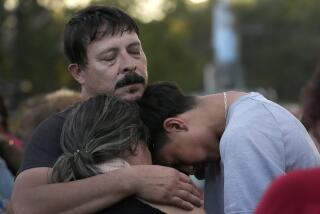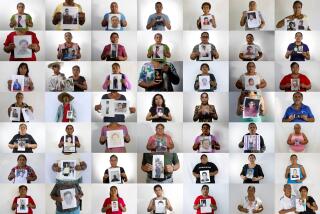‘Unable to locate’: The search for Tuscaloosa’s missing
Reporting from Tuscaloosa, Ala. — Police investigator Wade Elmore answered the phone.
On the line was the father of 21-year-old Latoya Brown. He hadn’t heard from his daughter since she left home Wednesday to visit a shopping center directly in the path of a tornado that smashed into the city.
“OK, and nobody’s talked to her since?” Elmore asked Monday. A pause. “Is it normal for her to be gone for a night or two at a time?”
He scribbled the answers on a sheet of paper.
Tuscaloosa’s roll of the missing, which has contracted and expanded like an accordion in the five days since the tornado struck, grew one name longer.
Elmore is one of a dozen police officers pulling 12-hour shifts in the city’s effort to locate hundreds of people reported missing. They work the phones and type into laptops at police headquarters, struggling to separate the temporarily out-of-touch from the truly missing — and feared dead.
It is a tedious and often frustrating task. As soon as a missing college student is found couch-surfing at a buddy’s house, an office manager calls to say that an employee hasn’t been heard from since Wednesday.
The official number of missing, which was as low as 10 early on, stood at 326 Monday night, said Tuscaloosa Mayor Walter Maddox. Asked whether he believed at least some names would ultimately prove to be fatalities, the mayor took a deep breath and replied:
“I’m prayerful, but the longer we go through this, the more I’m concerned that the final number will be more devastating than we could ever imagine.”
Police have cleared 676 names from the list of people previously reported missing. But no sooner are names stricken than fresh reports flow in to swell the list again.
Sgt. Tim Guy, who oversees the effort, said the list was less a roster of truly missing people and more a compendium of “unable to locate.” Police have gotten calls about missing people from friends or relatives in England, Norway and Iceland.
“We’ve had people calling about long-lost cousins or people they thought used to live here,” Guy said, adding that some have called about friends they haven’t seen in years.
In many cases, it turns out the person on the list doesn’t live in Tuscaloosa. One family that a friend thought was missing had moved to Texas.
Often, the team is able to locate someone missing with a simple phone call, Guy said.
But with thousands of homes destroyed, power knocked out and some phone lines still down, many aren’t reachable by phone.
In that event, officers ask search and rescue teams to look for people at their last known locations. But the tornado hit at 5 p.m. — rush hour — and many people don’t know exactly where their loved ones were.
Tuscaloosa is a college town full of young people with shallow roots in the place. It also has a significant elderly population that is difficult to track on the Internet.
In some cases, when officers have good information that a missing person was in one of the hardest-hit areas of town at the time of the storm, the city dispatches cadaver-sniffing dogs.
That’s what happened Sunday, when a team of search dogs and firefighters scoured a leveled apartment complex in Tuscaloosa looking for Marcus Smith, 22, whose family was certain he was in his apartment as the tornado bore down on the city. They hadn’t heard from him since.
Just after 3 p.m., the dogs helped the team find Smith’s remains. He became the storm’s 40th fatality in Tuscaloosa County.
The search teams were back at it Monday. By midafternoon, no more bodies had been recovered.
Tuscaloosa Fire and Rescue Sgt. Shawn Morrow, a member of the recovery team that found Smith’s body, said his gut tells him that most people reported missing won’t be found in the city’s enormous mounds of rubble.
“If there were 700 or 800 bodies out here, we’d be falling all over them,” Morrow said.
In a golf cart Monday afternoon, Morrow traced the path of the storm, stopping to ask residents whether all their neighbors were accounted for.
On the northeastern edge of Tuscaloosa, where the city gives way to pretty hills dotted with oak and pine trees, Morrow sidled up to a couple clearing wood in their front yard.
“Have you got everybody accounted for?” he asked.
The man nodded. “We’re all OK,” he said. “Just the cat’s missing.”
In addition to the city’s list of missing, the Tuscaloosa News on Sunday published three pages of pleas from people seeking missing friends and relatives — more than 900 names. Other appeals have appeared on Facebook.
The Times randomly called more than a dozen names from the Tuscaloosa News and Facebook lists. In every case, people who had submitted names said those feared missing had since been located.
Guy said he expected that most of the people now listed as missing would be found. He hoped to pare another 150 names from the list by the end of the day Monday with the help of a computer program created by an information technology team at the University of Alabama.
Sometimes clearing the names provides a special satisfaction. After the storm, worried members of a local church called police with the names of an elderly couple they said was missing.
Guy found it easy to cross the couple’s names off the list, for he happened to know they were very much alive. They were his grandparents.
Times staff writer Richard Fausset in Tuscaloosa contributed to this report.
More to Read
Sign up for Essential California
The most important California stories and recommendations in your inbox every morning.
You may occasionally receive promotional content from the Los Angeles Times.












